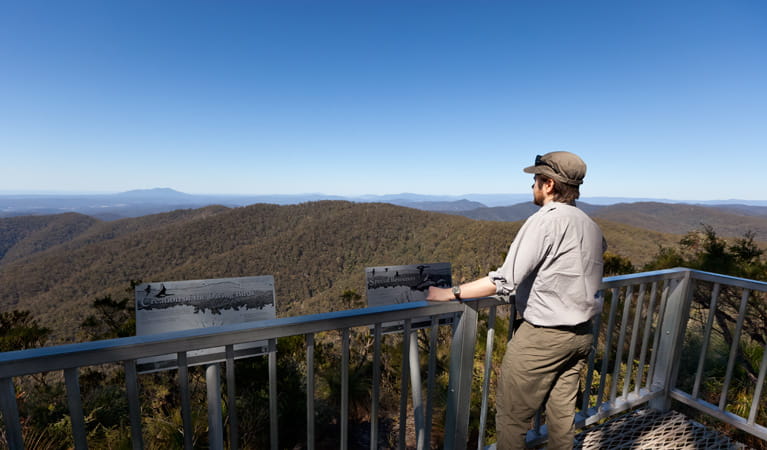Deua National Park
Overview
Deua National Park, where you can hike, drive, camp, swim, lilo, canoe, picnic and birdwatch, lies between the New South Wales towns of Braidwood, Moruya and Cooma.
Read more about Deua National Park
An easy day trip from Cooma, Braidwood, Moruya and even Canberra, Deua National Park has enough activities for everyone.
Hikers can enjoy a walk from Berlang campground to gaze at the gaping chasm of The Big Hole. Further along the same track is the ancient rock feature of Marble Arch where stalactites hang from ancient elevated ceilings. Canoeists and lilo-lovers can paddle and float down the Deua or Shoalhaven rivers, both of which are ideal for swimming, while birdwatching is at its best in the spring when the birds feed on the park’s wildflowers.
If you’re looking for an even greater experience, stay overnight at one of a number of campgrounds spread throughout the park, most of which are riverside. During your stay at Bendethera Valley campground, keep an eye out for remains of the area’s pastoral heritage.
Local alerts
For the latest updates on fires, closures and other alerts in this area, see https://www.nationalparks.nsw.gov.au/visit-a-park/parks/deua-national-park/local-alerts
Contact
- in the South Coast, Country NSW and Snowy Mountains regions
Deua National Park is always open but may have to close at times due to poor weather or fire danger.
-
-
Narooma office
02 4476 0800
Contact hours: Monday to Friday, 9am to 4pm. Office open by appointment only. Closed public holidays. - 10 Graham Street, Narooma NSW 2546
-
Email: npws.eurobodalla@environment.nsw.gov.au
-
Narooma office
Visitor info
All the practical information you need to know about Deua National Park.
Map
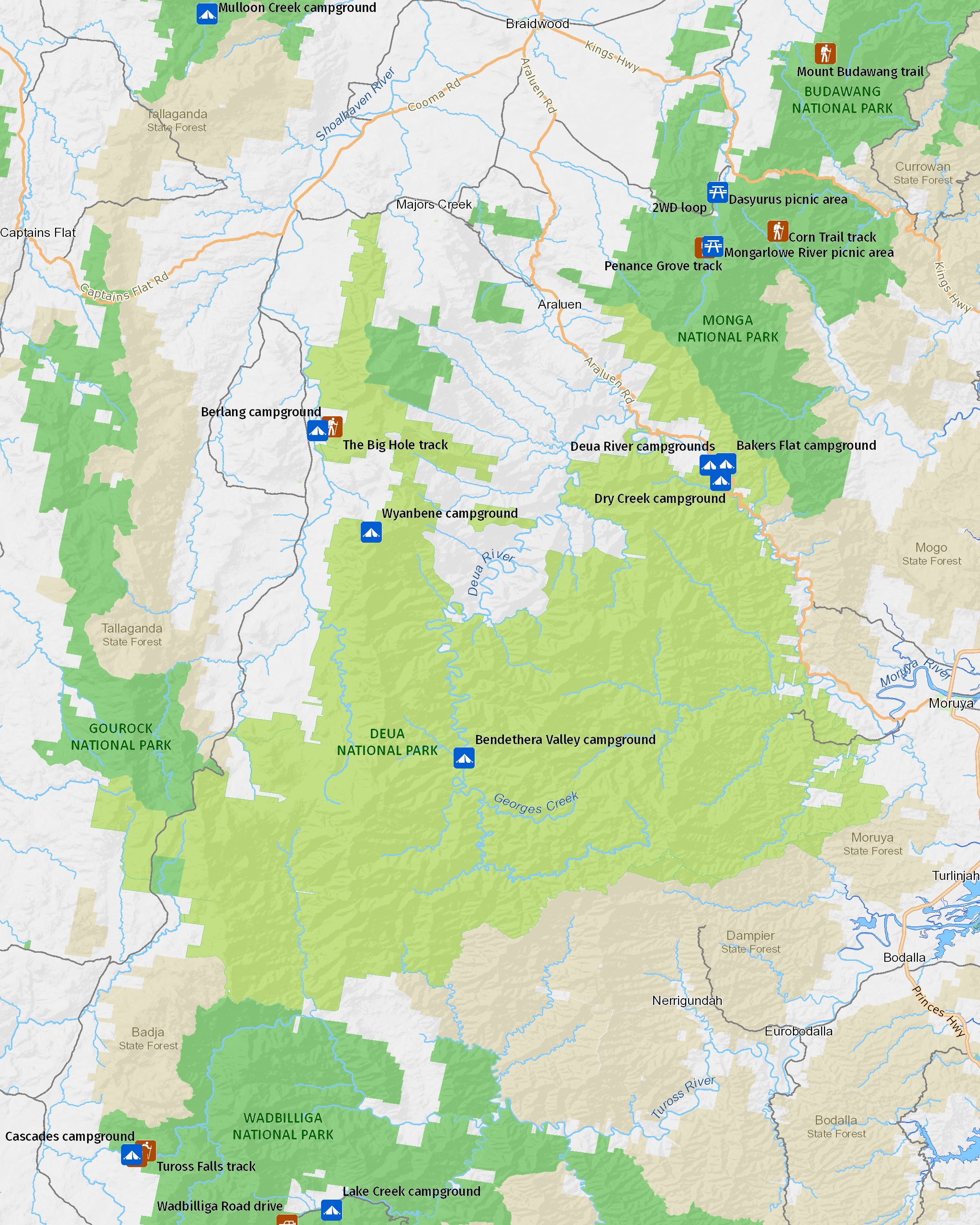
Map legend

Getting there and parking
Get driving directions
From Braidwood:
- Drive south along Cooma Road for 30 minutes
- Turn left at the sign to Berlang/The Big Hole
From Moruya:
- Drive west along the Araluen Road for 45 minutes until you reach Deua River campgrounds
From Cooma:
- Drive northeast along the Numeralla Road for 70 minutes to Middle Mountain Road and turn right into the park
Parking
- Berlang campground See on map
- Deua River campgrounds See on map
By bike
Check out the Bicycle information for NSW website for more information.
By public transport
For information about public transport options, visit the NSW country transport info website.
Best times to visit
There are lots of great things waiting for you in Deua National Park. Here are some of the highlights.
Spring
This season is the best time for wildflowers in the park and for birdwatching.
Summer
This is the season for swimming and floating on a lilo down the Shoalhaven and Deua rivers. See if you can spot an eastern water dragon sharing the river with you along the way.
Weather, temperature and rainfall
Summer temperature
Average
15.7°C and 23.5°C
Highest recorded
43.3°C
Winter temperature
Average
6.5°C and 16.7°C
Lowest recorded
-10°C
Rainfall
Wettest month
March
Driest month
August
The area’s highest recorded rainfall in one day
275.3mm
Facilities
Toilets
Picnic tables
Barbecue facilities
Maps and downloads
Prohibited
It’s a legal offence to drive an unregistered motor vehicle or motorcycle on any NSW road or in a NSW national park.
Pets
Pets and domestic animals (other than certified assistance animals) are not permitted. Find out which regional parks allow dog walking and see the pets in parks policy for more information.
Smoking
NSW national parks are no smoking areas.
Nearby towns
Moruya (25 km)
Moruya is a historic dairy town on the Moruya River surrounded by dairy pastures and rugged national parks.
Braidwood (41 km)
Braidwood was the first town to be listed on the NSW State Heritage register. Today, you can tour the town on a self-guided heritage walk and see dozens of impressive historic buildings dating from the gold-rush days.
Cooma (71 km)
The Snowy Hydro Discovery Centre is a state-of-the-art visitor facility showcasing the story of the Snowy Mountains Hydro-Electric Scheme from the early construction days to the role the scheme plays today in the development of Australia.
Learn more
Deua National Park is a special place. Here are just some of the reasons why:
The trails of time
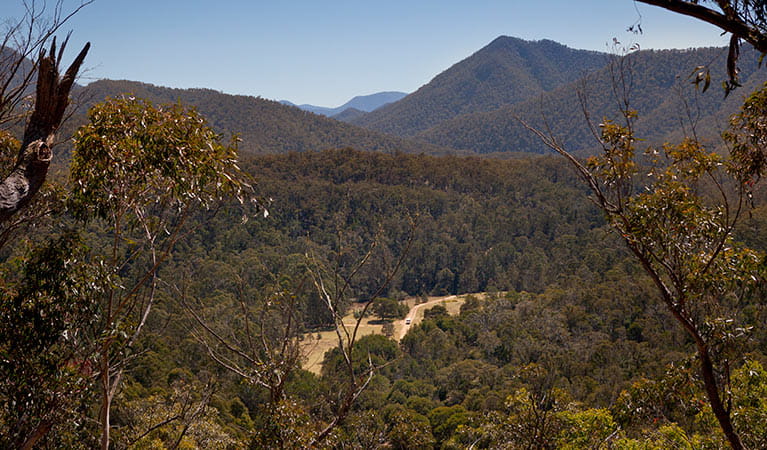
Passed on through generations in story and in song, the history of Aboriginal people of this land and their connection with all that surrounds them is very much a part of what you'll see in Deua National Park. Having travelled up and down the escarpment along well-worn pathways between the coast and the Monaro Tablelands for thousands of years, there are many places of spiritual significance. Scarred trees, grinding grooves and middens can be seen along the 'dreaming trails' of Deua.
Powerful stuff
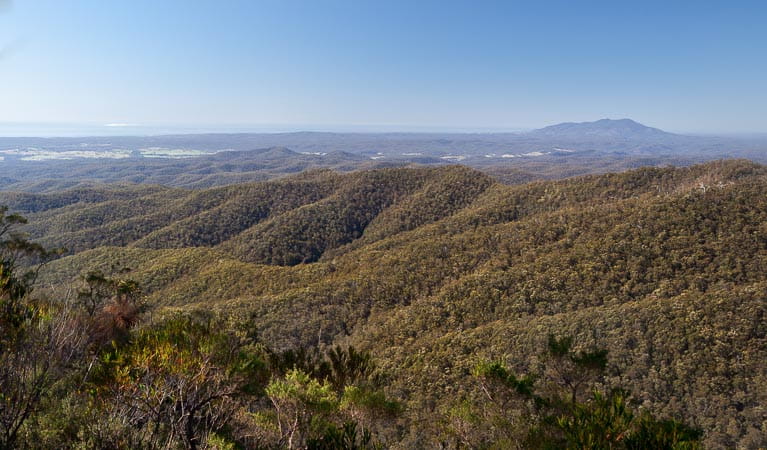
Deua is home to over 106 species of birds. There is a particularly high diversity of birds of prey in the park, such as the powerful owl and the peregrine falcon. The powerful owl is Australia's largest owl. The peregrine falcon, which is the fastest creature in the animal kingdom, can reach over 300km/hr in a high-speed dive when hunting. So if you see a dark vertical blur in the sky over Deua, you'll know now what it is and why it's moving so fast.
- The Big Hole walking track It’s an adventurous walk from Berlang campground to the viewing platform at The Big Hole as long as you don’t mind getting your feet wet crossing Shoalhaven River along the way.
Diverse scenery and luscious landscapes
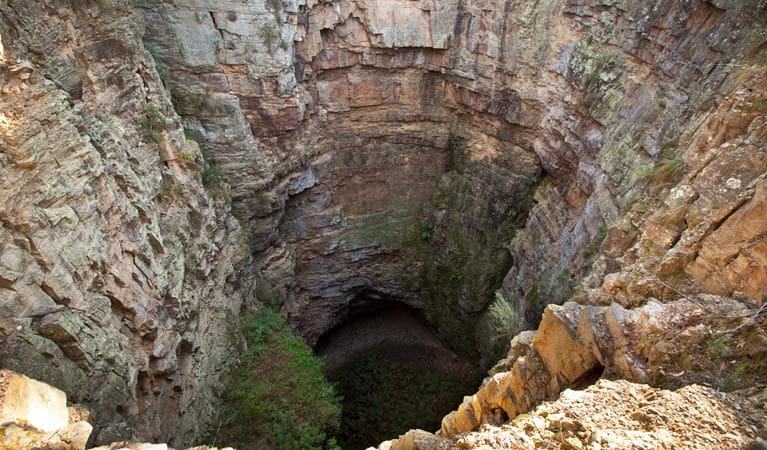
From grassy woodlands on the lower eastern slopes of Deua Valley, to the peatlands and swamps on the tablelands, there are landscapes aplenty at Deua National Park. Valleys dissected by wild rivers, rugged mountains, deep gorges, dry ridges, steep escarpments, limestone karst and high plateaus are also some of the diverse landforms you'll find at Deua National Park. The Big Hole is thought to have been an underground cave until the ceiling collapsed and now is a 96m deep and 50m wide pit. Marble Arch has a car-sized boulder over its entrance and inside this cave are animal remains believed to be thousands of years old. Bendethera Cave is over 250m long, 320m wide and contains massive limestone formations in caverns with up to 15m high ceilings. Rocky outcrops found throughout the park support unique and rare species of gum trees, like the woila and jilliga ash, whilst the limestone slopes in Bendethera Valley is the only known location of Bendethera wattle; a sight to behold as they blossom during spring. The drier and cooler conditions allow pinkwoods and soft tree ferns to thrive in the higher altitudes of the eastern escarpments, and grey myrtle, lilly pilli and mock olives can regularly be seen along the small creeks and gullies throughout.
- The Big Hole walking track It’s an adventurous walk from Berlang campground to the viewing platform at The Big Hole as long as you don’t mind getting your feet wet crossing Shoalhaven River along the way.
Education resources (1)
What we're doing
Deua National Park has management strategies in place to protect and conserve the values of this park. Visit the OEH website for detailed park and fire management documents.

